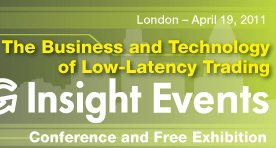 The Business and Technology of Low Latency Trading (BTLLT) event in London by ATeamGroup took place today. Some of the topics of interest were:
The Business and Technology of Low Latency Trading (BTLLT) event in London by ATeamGroup took place today. Some of the topics of interest were:
- TIBCO Financial Services CTO Spencer Greene gave an excellent visionary keynote covering the move from “Trading 2.0 to Trading 3.0”, such as the move from event focus to parallelism focus, Business Intelligence to (“really!”) real-time rules, and Risk and Compliance to Predictive Analytics. Spencer also talked about the need for very accurate latency measurements (via IEEE1588 Precision Time Protocol), the future of distributed memory (Intel Quickpath), CEP and memory appliances, FPGA in the network, cell processing… and the irony of the dichotomy of one trend for the abstraction and layering of software to reduce cost and risk, versus the trend for optimisation of processing for lowest latencies.
. - The TIBCO Messaging team ran an invitation-only training session on TIBCO FTL. I attended a different session, so can’t report on much there except I poked my head round the door and the room seemed packed. [There is a New York session too, if you are interested].
. - The session on “Deploy Fast and Built to Last” covered some low latency CEP technology areas (Traderserve, OneMarketData, and Sybase / Aleri) and Oracle (pushing the dominance of Java for trading systems). Some of the comments raised were:
- Some algorithms in trading can have large development yet small lifecycles: for example 100 IT developers and 20 quants supporting an algorithm with a lifetime of 4 days to 4 weeks; clearly the traditional 6-8 week testing cycle does not work in these situations and CEP technologies can improve productivity (and hopefully testing!).
- Other algorithms can last for years, presumably acting as templates with tweaks as required.
- Apart from time2market, other drivers for change are new counterparties, datafeeds, technologies etc.
- Customers always have to balance flexibility (of a tool) versus performance (optimising own code): for example the question of code generators versus code optimisations.
- 80% of trading applications are built using Java.
- One of the biggest problems in algorithm development and deployment is… the quality of the data from the market feeds. An instance was mentioned of a market feed supplier sending out test data as if it was live feed data…
.
- Although most of the exhibitors seemed to be showing hardware (network cards, server racks, …), there were a few hidden signs of CEP:
- Sybase was exhibiting their analytic database, and made some mention of their Aleri technology (see above).
- Ingres was also hosting SQLStream on their stand.
- Trade latency monitor Velocimetrics mentioned they were using CEP under the covers.
Overall a nicely organised and interesting event!





